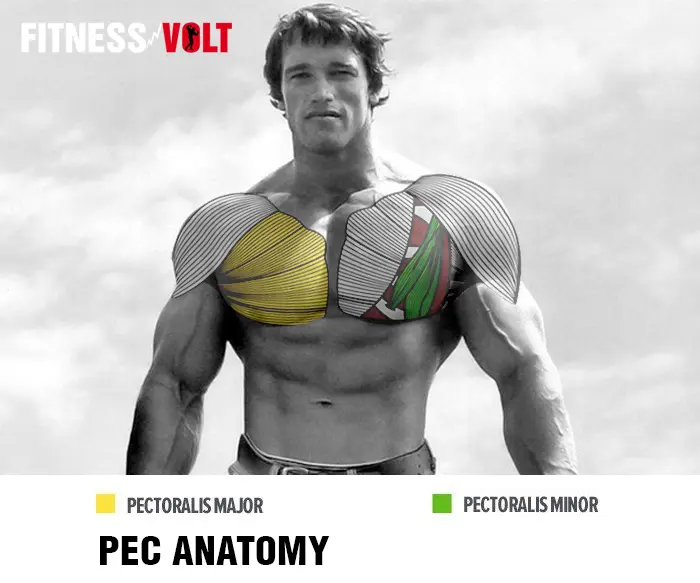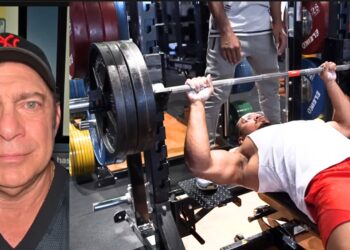The bench press is arguably the most popular strength training exercise. Powerlifters do it to build and test upper body strength, and bodybuilders do it to increase chest muscle mass. It’s also used to test upper body strength and endurance by athletes from a whole host of sports, including the NFL.
But, as popular and effective as the bench press is, like any exercise, it can lose some of its potency if you do it too often.
Studies have shown that changing exercises from time to time is as crucial as your set and rep scheme and workout intensity for building muscle (1). So, if you keep on doing regular bench presses, your muscular development and strength may stall.
Of course, if you are a powerlifter, your training should include plenty of bench presses done in the traditional way. After all, that’s what you’ll be doing in competition. Specificity matters and you should train mostly how you’re going to compete.
But, if you are more interested in general strength and bodybuilding, doing variations of the barbell bench press could help you reach your goals faster.
In this article, we share 13 unique bench press variations for massive pecs!
Level Up Your Fitness: Join our 💪 strong community in Fitness Volt Newsletter. Get daily inspiration, expert-backed workouts, nutrition tips, the latest in strength sports, and the support you need to reach your goals. Subscribe for free!
Pec Anatomy Basics
While you don’t need a degree in functional anatomy to build a bigger chest, knowing a little about how your pecs work can help you choose the best exercises for your goals.
Known as the pecs for short, the pectoralis major is a large, thick, fan-shaped muscle located on the upper part of your chest. Its name comes from the word pectus, the Latin word for breast.
This muscle makes up the bulk of your chest mass. The underlying muscle, pectoralis minor, is much thinner and doesn’t contribute much to your chest size.
The pectoralis major is a convergent muscle with three broad attachment sites that come together at a single insertion point.
It can be divided into two sections or heads – the clavicular or upper head and the sternal or lower head (2). The sternocostal head is also known as the abdominal head.
The functions of the pectoralis major are…
The Clavicular head:
- Shoulder flexion
- Horizontal adduction
- Internal rotation
The Sternocostal head:
- Shoulder extension
- Horizontal adduction
- Internal rotation
The clavicular head of the pectoralis major, often just called the upper pecs, is more active during incline chest exercises. Conversely, the sternocostal head, or lower pecs, is more active during decline movements (3). Because of this, you must train your pecs from multiple angles to develop them fully.
13 Unique Bench Press Variations for Massive Pecs
Whether you want to build muscle or increase your bench press 1RM, these unique bench press variations will help.
Use them in place of standard bench presses or as a secondary assistance exercise after your main bench press workout.
Or, if you train your chest twice a week, use your choice of alternatives to make up your second workout.
1. Wide Grip Bench Press
Bodybuilders do bench presses to build a bigger chest. Using a wider than shoulder-width grip increases the range of motion at your shoulder joint and, therefore, pec muscle engagement. However, this also means you won’t be able to lift as much weight, and wide grip bench presses can also be hard on your shoulders.
Still, if you want to hit your pecs harder, and they don’t bother your shoulders, wide grip bench presses could be a helpful addition to your chest workouts.
Read more about this old-school pec pumper here.
2. Close Grip Bench Press
Where wide grip bench presses hit your pecs harder, moving your hands closer together emphasizes your triceps. Close grip bench presses target your inner chest and, as an added advantage, are often easier on your shoulders than standard and wide grip bench presses.
Learn how to do this exercise here.
3. Paused Bench Press
A lot of bench pressers are cheating themselves out of their gains! They either do partial reps and stop short of touching their chests with the bar or bounce the bar off their sternums. Both faults make the mighty bench press less effective and even dangerous.
With paused bench presses, you lower the bar under control and then pause with the bar touching your chest for 2-3 seconds before driving it forcefully back up. This not only makes your reps more honest; it also increases time under tension and pec engagement, making your workout more effective.
Pausing instead of bouncing also takes stress off your shoulder joints, which could be very welcome if bench pressing causes shoulder pain.
4. Gironda Guillotine Press
Vince Gironda was one of the most influential trainers in bodybuilding history. As well as being an accomplished bodybuilder himself, Gironda worked with Mr. Olympia winners and the Hollywood elite during the late 1960s, 70s, and early 80s.
Known as the Iron Guru, Gironda believed that the regular bench press was not a very effective chest builder, stating it worked the shoulders more than the pecs. In response, he developed a bench press variation that involved more pec engagement – the Gironda guillotine press.
This exercise has fallen out of favor over the last few decades, but it’s still an effective chest builder. However, because it’s a somewhat risky exercise (you lower the bar to your neck!), you should always do the Gironda guillotine press with a spotter or in a power rack.
Learn how to do the Gironda guillotine press here.
5. Dead Stop Bench Press
Almost every other variation of the bench press starts with your arms straight. Dead stop bench presses start with the bar resting on the pins of a power rack set to chest height. Powerlifters do this exercise to increase explosive power, and it’s also a great way to increase muscle fiber recruitment for greater hypertrophy.
To do dead stop bench presses, put your bench in a power rack and set the safety pins at just above chest height. Start each rep with the bar resting on the pins.
Level Up Your Fitness: Join our 💪 strong community in Fitness Volt Newsletter. Get daily inspiration, expert-backed workouts, nutrition tips, the latest in strength sports, and the support you need to reach your goals. Subscribe for free!
6. 1 ½ Rep Bench Press
This unique bench press variation increases time under tension and pec activation, making it an excellent choice for bodybuilders. Don’t go too heavy too soon with this exercise; it’s a whole lot harder than it looks!
How to do it:
- Unrack the bar as usual.
- Bend your arms and lower the bar to your chest.
- Press it halfway up.
- Lower the bar back to your chest.
- Drive it all the way up until your arms are straight but not locked.
- That’s one rep – keep going!
7. Uneven Weight Bench Press
For this variation, all you need to do is put slightly more weight on one end of the bar – no more than about 5-10 pounds. This will overload one arm and side of your chest. It’ll also force you to stabilize your core more strongly.
Make sure you swap sides set by set to avoid any strength imbalances. Finally, work hard to keep the bar level, despite the weight disparity.
This exercise DOES feel weird the first time you do it, but you will be a lot more stable when you return to regular barbell bench presses.
8. Earthquake Bench Press
This bench press variation creates a lot of instability, so the bar shakes in your hands. This challenges and develops better joint stability and also increases pec engagement.
You can use a special earthquake bar made of flexible material or just hang weights from a standard Olympic barbell using resistance bands. Either way, this is a challenging bench press variation, so don’t go too heavy too soon.
9. Release and Catch Smith Machine Bench Press
This exercise is the weight training equivalent of plyometric push-ups. Pressing the bar up explosively will upper-body pushing power. Power is your ability to generate force quickly. Explosive movements are helpful for athletes training to punch harder or throw further but can also build muscle as they engage lots of myofibrils simultaneously.
Needless to say, this is a somewhat risky exercise. Protect yourself by putting the stoppers in place so that the bar won’t hit your chest if you fail to catch it. And no, you should NOT do this exercise using a freeweight barbell!
How to do it:
- Place your bench in the Smith machine. Set the weight stoppers to just above chest height.
- Lie on the bench, unrack the bar, and lower it to your chest.
- Drive the weight up and release it, so it continues upward. Keep your arms extended.
- Catch the bar as it comes back down and descend into another rep.
- Do not pause between reps. Instead, try and maintain a constant rhythm.
10. Eccentric Emphasis Bench Press
You are stronger eccentrically than you are concentrically. In plainer language, that means you can lower more weight than you can lift. Make the most of this physiological phenomenon by emphasizing the eccentric phase of your bench press reps. Be warned, eccentric emphasis reps cause a lot of muscle trauma. That’s good for hypertrophy but not so good for post-workout soreness!
How to do it:
- Unrack the bar as normal.
- Bend your arms and take 4-8 seconds to lower the bar to your chest.
- Without bouncing, drive the bar back up and repeat.
11. Bench Press with Bands or Chains
Using bands or chains with free-weights is called accommodating resistance. These training tools increase the load as you extend your arms and approach lockout. This can be useful for overloading your triceps, taking stress off your shoulders, or increasing explosive power as you drive the bar up and off your chest.
While some gyms have chains, bands are arguably the most convenient way to do accommodating resistance bench presses as they’re light, portable, and affordable.
How to do it:
- Attach a loop-type resistance band to your barbell and then secure it to the floor using a heavy dumbbell. Some power racks and bench press stations have pegs for this purpose.
- Unrack the bar as normal and lower it to your chest. Work hard to control the descent, and don’t let the bands snap it down toward your chest.
- Pause for a second and then drive the bar up to arms’ length.
12. Reverse Grip Bench Press
There aren’t many bench press variations more unique than reverse grip bench presses. Primarily targeting your upper pecs, reverse grip bench presses were once a staple exercise for many bodybuilders, but they’re much less common now. Some lifters find this variation more shoulder-friendly than regular barbell bench presses.
How to do it:
- Lie on your bench with your eyes beneath the bar. Plant your feet firmly on the floor. Brace your abs. Reach up and grab the bar with an underhand, slightly wider than shoulder-width grip. Pull your shoulders down and back.
- Unrack the bar, bend your arms, and lower it to your sternum. Your elbows will naturally come in toward your ribs as you descend.
- Drive the bar back up and repeat.
13. Spotto Bench Press
The Spoto bench press is named after champion powerlifter and arm-wrestler Eric Spoto. Like exercise #3, the Spoto press involves a mid-rep pause. However, for this exercise, you stop the bar 3-6” above your chest instead of touching it.
The Spoto press increases time under tension for hypertrophy and breaks up the eccentric/concentric contraction cycle, which means you have to work harder to drive the weight back up. This is useful for developing strength and power.
Learn more about the Spotto press in this in-depth guide.
Bench Press Variations – Wrapping Up
While we would never dream of suggesting that you should give up bench pressing, we do believe that you can have too much of a good thing.
Regular bench presses are definitely a good exercise. Still, if you do them too often, you run the risk of becoming accustomed to their effect, and they’ll lose some of their hypertrophic power.
So, while you don’t need to quit bench pressing, you can maintain your progress by using any of the 13 unique bench press variations shared above. Each one is an effective chest exercise, and with so many different options to choose from, your chest workouts should never be boring.
References:
1- PubMed: The Effects of Exercise Variation in Muscle Thickness, Maximal Strength and Motivation In Resistance Trained Men https://pubmed.ncbi.nlm.nih.gov/31881066/
2- Encyclopedia Britannica: Pectoralis Muscle https://www.britannica.com/science/pectoralis-muscle
3- PubMed: An Electromyography Analysis Of 3 Muscles Surrounding the Shoulder Joint During the Performance of a Chest Press Exercise at Several Angles https://www.ncbi.nlm.nih.gov/pubmed/20512064
Interested in measuring your progress? Check out our strength standards for Bench Press, Push Ups, Smith Machine Bench Press, and more.









